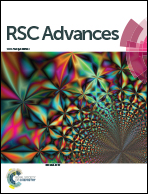19F NMR spectroscopy for the quantitative analysis of carbonyl groups in bio-oils†
Abstract
The carbonyl groups in pyrolysis oil have been reported to be responsible for the two most challenging properties with regard to the usage of pyrolysis oil – corrosion and aging problems; indeed, the carbonyl groups also bring huge difficulties for any required upgrading process. Therefore, a comprehensive and quantitative understanding of the structural information on these carbonyl groups is a challenging but crucial topic. However, owing to the highly complex nature of pyrolysis oil, how to quantitatively determine carbonyl groups appears to be very important. To the best of our knowledge, this is the first study that has used the 4-(trifluoromethyl)phenylhydrazine derivatization 19F NMR spectroscopy method for the quantitative analysis of carbonyl groups in various bio-oils. Different pyrolysis oils produced from various sources were analyzed after treatment with 4-(trifluoromethyl)phenylhydrazine followed by 19F NMR spectroscopy, and semiquantitative FT-IR spectroscopy, and were also quantitatively determined by the wet chemistry oximation method. The results indicated that the 19F NMR method can be regarded as more efficient (24 h vs. 48 h; single step vs. multiple steps) while being as reliable as the traditional oximation method.


 Please wait while we load your content...
Please wait while we load your content...